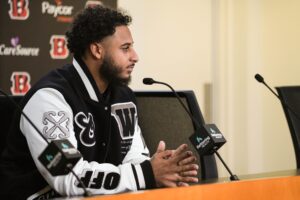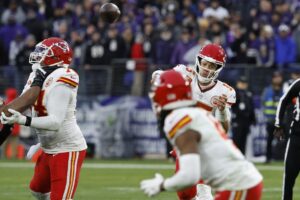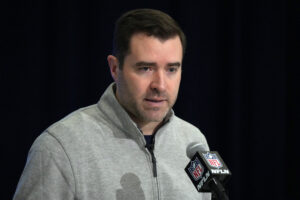The most anticipated part of the off-season is officially in the rearview mirror, as the 2018 NFL Draft has officially passed. Every team in the league added young talent to their squad, but which teams made the biggest improvements? This installment of the 2018 NFL Draft Grades features an in-depth breakdown of every team in the AFC East and the AFC West.
AFC North and South Draft Grades
NFC East and West Draft Grades
NFC North and South Draft Grades
AFC East and AFC West 2018 NFL Draft Grades
Buffalo Bills: D
Players Added: Josh Allen, Tremaine Edmunds, Harrison Phillips, Taron Johnson, Siran Neal, Wyatt Teller, Ray-Ray McCloud, Austin Proehl
The Buffalo Bills low draft grade is primarily due to one pick: quarterback Josh Allen. Yes, he can throw the ball to the moon and back. His arm is an absolute rocket, but everything else about him screams bust.
While there’s no part of the field Allen’s arm can’t reach, it’s anyone’s guess where the ball actually goes. Allen has no accuracy deep, no touch on short passes, not nearly enough football IQ to understand an NFL defense, and zero semblance of consistency. In spite of all that, the Bills fell in love with his arm, telling themselves they could teach him the “basic” parts of being a quarterback.
The problem with that logic is that every step of his life, someone has been trying to teach Allen the easy parts of quarterbacking. They haven’t been able to do it. Why would Allen suddenly be able to put touch on a ball against the best competition in the world when he couldn’t do it in college? It’s hard to grade a draft class on one pick, but selecting (and trading up for) Allen 7th overall marries the franchise to this kid. This is three wasted years of everyone’s that nobody will ever get back.
As for the rest of the picks, Edmunds was an incredibly strong pickup at 16th overall. The Bills linebacking corps is old and worn down, and Edmunds should provide a solid burst of life. He was arguably the best coverage linebacker in the draft, and seeing him face off with Patriots tight end Rob Gronkowski twice a year will be must-see TV.
Fifth-round guard Wyatt Teller might be the steal of the Bills draft. With Richie Incognito out of the picture, the late-round selection could end up starting the season opener.
New England Patriots: B
Players Added: Isaiah Wynn, Sony Michel, Duke Dawson, Ja’whaun Bentley, Christian Sam, Braxton Berrios, Danny Etling, Keion Crossen, Ryan Izzo
It was an interesting draft for the New England Patriots, and one that was partially ruined by the Tennessee Titans. On two separate occasions, the Titans traded to jump one pick ahead of New England and took a player that would have filled a team need. In the first round, the Titans traded up to the 22nd overall pick to select Rashaan Evans, who would have been a great fit with New England. In the second round, the Titans traded up to the 41st overall selection, drafting EDGE Harold Landry.
Most of the moves the Patriots actually made were solid selections. Offensive lineman Isaiah Wynn was a phenomenal selection and should fit seamlessly along the offensive line. While some question his height, all signs point towards Wynn being used at left tackle, at least initially.
As far as late-round selections go, New England got two steals in linebacker Christian Sam and wide receiver Braxton Berrios. Sam is the perfect missing piece to the Patriots defense, as the team desperately needed a linebacker capable of covering running backs out of the backfield. Braxton Berrios was made for New England and could be the heir to Julian Edelman as the slot receiver of the future.
While New England got good players with all of their picks, it’s interesting to see which positions they outright avoided. Entering the draft, two of the teams biggest needs were at linebacker and quarterback. While New England drafted two linebackers, they were fifth- and sixth-round selections, respectively. Additionally, the Patriots waited until the seventh round to draft a quarterback, despite starter Tom Brady being 41.
New York Jets: B
Players Added: Sam Darnold, Nathan Shepherd, Chris Herndon, Parry Nickerson, Foley Fatukasi, Trenton Cannon
The New York Jets draft grade stays at a B primarily because they only had two selections within the top 100. However, they certainly made the most of those two selections. With the third overall pick, Gang Green added Sam Darnold, who has all the makings of a franchise quarterback.
Several analysts around the league had Darnold as the top quarterback in the draft, so having him slide to three should be a dream come true for Jets fans. It’s been a very long time since New York has had an answer under center, but those days may be at an end.
The rest of the Jets draft was solid if unspectacular, selections. Fourth-round tight end Chris Herndon is a good dual-threat tight end, although he is better as a blocker. Depending on how training camp sorts out, he very well could be the teams primary tight end.
Nathan Shepherd is a classic high-risk, high-reward pick. After taking Darnold third overall, the Jets made Shepherd their other top-100 pick. On paper, Shepherd has all the measurables to succeed. He’s a great athlete, and moves a lot better than his 6’-4”, 315-pound frame would suggest. However, he’s never put all that athleticism together, which is a worry at age 24.
Miami Dolphins: B+
Players Added: Minkah Fitzpatrick, Mike Gesicki, Jerome Baker, Durham Smythe, Kalen Ballage, Cornell Armstrong, Quentin Poling, Jason Sanders
The Miami Dolphins roster is full of holes, so just about any player they could have added would fill a need. That being said, they got one of the best values in the entire draft by selecting Minkah Fitzpatrick with the 11th overall pick. Miami was the beneficiary on an early run of quarterbacks, as a borderline top-five talent fell into their laps at 11. Fitzpatrick drastically improves the Dolphins defense, and Miami’s secondary should be the strength of the team.
While none of their other picks were as good as the Fitzpatrick selection, Miami still managed to bring in quite a few solid pieces. Tight end Mike Gesicki’s pass-catching skills fit perfectly within head coach Adam Gases’ offense, and third-round selection Jerome Baker should be a Week One starter at outside linebacker. Kalen Ballage is the classic high-risk, high-reward running back selection Miami has become famous for. If history is any indication, Ballage will probably pan out for the Dolphins.
That being said, it wasn’t a perfect draft for Miami. Fourth-round selection Durham Smythe is basically just a blocking tight end, and drafting him in the fourth round was a bit of a reach. Players like him are a dime a dozen. Sixth-round selection Cornell Armstrong was something of a shock, as most analysts had him going undrafted.
Additionally, the Dolphins made no efforts to replace departed defensive tackle Ndamukong Suh. Miami made eight selections, but none went to the now-depleted defensive line. Also, the Dolphins didn’t draft a quarterback, meaning they’re comfortable with Ryan Tannehill as the unquestioned starter for 2018.
Denver Broncos: A-
Players Added: Bradley Chubb, Courtland Sutton, Royce Freeman, Isaac Yiadom, Josey Jewell, DeSean Hamilton, Troy Fumagalli, Sam Jones, Keishawn Bierria, David Williams
The Denver Broncos had one of the best drafts in the league, adding ten players, all of whom can make an impact in some form. However, the best pick was easily defensive end Bradley Chubb. Chubb was widely considered the best defensive player in the draft, and Denver was fortunate enough to draft him with the sixth overall pick.
Chubb has the potential to be a one-man wrecking machine, and pairing him with Von Miller could lead to the best pass rushing duo in football. The 2015 Broncos were carried to a Super Bowl by an elite defense, and Miller and Chubb could be good enough to do that again.
Last years Broncos were done in by an anemic offense that disappeared for weeks on end. While they didn’t draft a quarterback, they added to great wide receivers in Courtland Sutton and DeSean Hamilton. Sutton should start the season as the third outside receiver but has the ability to produce as a legitimate starter. Hamilton is a slot receiver with the build of an outside receiver, similar to a better Jordan Matthews. With Emmanuel Sanders and Demaryius Thomas on the outside, Hamilton could produce against a lot of single coverage.
The only reason this draft class doesn’t get an A is because of the offensive line. The O-line was arguably the biggest flaw on the 2017 Broncos, and John Elway has done nothing to address that need. Hopefully new quarterback Case Keenum can survive under center, as the rest of the roster looks pretty solid.
Kansas City Chiefs: C+
Players Added: Breeland Speaks, Derrick Nnadi, Dorian O’Daniel, Armani Watts, Tremon Smith, Kahlil McKenzie
Lacking a first-round pick because of the Patrick Mahomes trade from last season, the Kansas City Chiefs made a variety of mostly-safe picks. However, while these picks were safe, none of these players are likely to blossom into superstars.
Kansas City’s biggest problem in 2017 was the defense, and this draft reflected that. Every player drafted save for McKenzie will help the defense, so kudos to Kansas City for attacking their biggest area of need. However, they may have been too aggressive in the pursuit of their earlier picks.
Kansas City gave up a third-round pick to move up and draft Speaks. Speaks has the talent to justify this move, but as of now, that potential is untapped. Head coach Andy Reed is banking on his ability to harness all that potential.
The Chiefs then gave up a fourth-round pick to move up 11 spots and select Derrick Nnadi. This was something of a head-scratcher, as Nnadi projects to only be a run-stuffing defensive tackle in the NFL. Giving up a fourth-round pick when several similar players were still on the board was an interesting decision, to say the least.
One player to keep an eye on is former Tennessee defensive lineman Kahlil McKenzie. While McKenzie played defensive line in college, the Chiefs already announced he’ll be an offensive guard moving forward. It’s always interesting watching players switch positions at the highest level. Several other teams looked at McKenzie as a guard, according to reports, and it will be interesting to see if the Chiefs can make this move work.
Los Angeles Chargers: A-
Players Added: Derwin James, Uchenna Nwosu, Justin Jones, Kyzir White, Scott Quessenberry, Dylan Cantrell, Justin Jackson
The Los Angeles Chargers may have gotten the steal of the draft in Florida State defensive back Derwin James. Projected by many as a top-ten or top-five selection, James somehow lasted long enough to be swooped up by the Chargers at pick 17. James will join Casey Hayword, Tre Boston, and Jason Verrett to form one of the most secondaries in the league. Combine that with an already ferocious front seven, and the Chargers could have the best defense in the NFL.
Adding Nwosu with the 48th overall pick was a case of the rich getting richer. Nwosu would compete to start on most rosters, but not in Los Angeles. Frankly, he’s not better than Joey Bosa or Melvin Ingram, so he’ll probably serve as a situational pass rusher, at least early on. How teams are supposed to block Nwosu, Bosa, and Ingram is anyone’s guess.
The Chargers one misstep came with the selection of Justin Jones at 84. While Los Angeles needed a nose tackle, selecting Jones was a major reach. Most analysts had him as a fifth- or sixth-round pick, and his game film backs that up. However, there weren’t many nose tackles left, and Los Angeles was blinded by their need. They passed up a chance at a good player for a borderline role player.
Oakland Raiders: C
Players Added: Kolton Miller, P.J. Hall, Brandon Parker, Arden Key, Nick Nelson, Maurice Hurst, Johnny Townsend, Azeem Victor, Marcell Ateman
Jon Gruden’s first draft at the helm was something of a mixed bag. While the Oakland Raiders acquired nine new players, almost all of which fit a need, there were several reaches in there. The worst move of the Raiders draft came with their first selection. After trading back five spots and only receiving a third- and fifth-rounder, Oakland selected offensive tackle Kolton Miller. While the Raiders needed a tackle, selecting Miller at 15 was a major reach. Miller’s not a perfect tackle by any means and was projected as a late-first rounder. When looking at the talent still on the board at the time of Miller’s selection, there’s no denying the Raiders overdrafted Miller.
Additionally, the Raiders made the odd decision to draft punter Johnny Townsend in the fifth round. While taking care of special teams is important, drafting a punter in the top 200 is a strange choice. There’s still plenty of talent on the board by pick 173, and a punter could have been selected later (or not at all, if they hadn’t released Marquette King). This move has shades of 2000 when Gruden selected Shane Lechler over Tom Brady.
Of course, the Raiders draft had some good moments too, such as the selection of Arden Key in the third round. Key has first-round talent, but concerns with marijuana usage caused his draft stock to plummet. Key put himself through rehab, and if he’s fully clean, he could be one of the best steals in this class.
Main photo:
Embed from Getty Images






